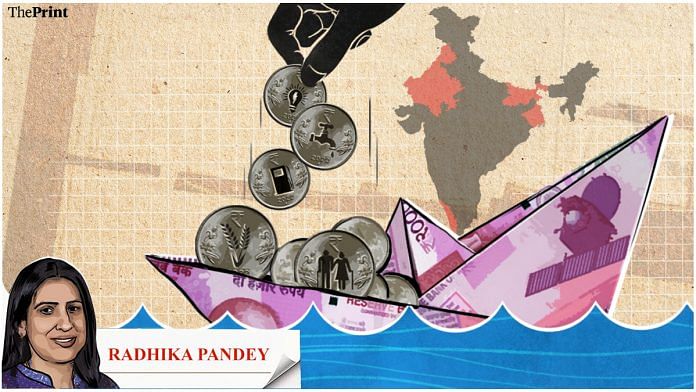A recent study by the Reserve Bank of India (RBI) highlighted the fiscal risks confronting the state governments in India. While the Covid-19 pandemic stretched the finances of the state governments due to collapse in revenues and increase in expenditures, the tendency to spend on freebies, revival of the old pension scheme by some states and the periodic bailout of the power distribution companies (DISCOMs) have worsened the position on state finances.
Undertaking power sector reforms, preventing leakages in the payment of subsidies and avoiding fiscally unwise decisions like the reversion to the old pension system can help improve the financial health of the states.
States’ fiscal profile prior to pandemic
Before the onset of the pandemic, states had managed to maintain their fiscal deficit below the three per cent ceiling mandated by the Fiscal Responsibility Legislation barring three years — 2009-10, 2015-16 and 2016-17.
In 2009-10, the overshooting of the target was owing to the global financial crisis, while in 2015-16 and 2016-17, the deviation was due to the UDAY scheme. Under the scheme meant for the revival of the debt-laden power distribution companies, sixteen states took over the debt of power distribution companies. The UDAY scheme led to overshooting of the fiscal deficit target by 0.7 to 0.8 per cent of GDP.
Another factor that had a bearing on the finances of states were the farm loan waivers announced by various states. Loan waivers add to the fiscal burden as they are essentially a transfer from tax payers to borrowers.
Estimates suggest that higher expenditure owing to farm loan waivers leads to increase in fiscal deficit to GDP ratio by 20-40 basis points. As borrowings by states increase to finance the higher expenditure, yields on state development loans (SDL) will inch up leading to higher interest burden for states.
Also Read: Indian economy has a twin deficit problem. To counter it, govt needs to juggle growth & stability
Finance Commission glide path & fiscally stressed states
While a number of states are fiscally vulnerable, the RBI study has identified Bihar, Kerala, Rajasthan, Punjab and West Bengal as highly stressed due to their higher debt levels, the fiscal deficit and the quality of expenditure.
These states have high debt to GDP ratios. Higher debt implies that a significant proportion of the revenue goes towards payment of interest. Most of these states spend more than 10 per cent of their revenue receipts on interest payments, with Punjab and West Bengal spending more than 20 per cent of their revenues on interest payment. A higher proportion of interest payments squeezes the fiscal space for more productive capital expenditure.
The first year of the pandemic saw the fiscal deficit of states surging to 4.7 per cent of GDP. The Fifteenth Finance Commission suggested a glidepath for fiscal consolidation for the central and state governments for the five-year period till 2025-26. For states, it recommended the fiscal deficit limit (as % of GSDP) of 4 per cent in 2021-22, 3.5 per cent in 2022-23, and 3 per cent during 2023-26.
Most of the fiscally stressed states (with the exception of West Bengal) exceeded the fiscal deficit target of 4 per cent set by the Fifteenth Finance Commission for 2021-22. Not only did they exceed the Finance Commission target, they also significantly deviated from their own budgeted targets. As an example, for Bihar, the revised fiscal deficit target was more than 11 per cent of its GDP as against a target of 2.97 per cent of GDP set during the budget for 2021-22.
The Finance Commission also suggested a glide path for states’ debt to GDP ratio. The Commission expects the states’ debt-GDP ratio to decline to 32.5 per cent by 2025-26. Punjab seems to be in a particularly difficult fiscal position. The state’s debt to GSDP has been 40 per cent or more for six years. Rajasthan also has debt levels touching 40 per cent of its GDP.
Own tax revenues & reliance on central govt
On average, the share of own tax revenue as a share of total revenue of states is around 48 per cent. For the rest, states rely on tax-sharing from the central government and transfer of grants-in-aids.
For some states such as Bihar, Assam, Himachal Pradesh and Jharkhand, the share of own tax revenues in revenue receipts is much below the average. More worrying is the fact that states like Karnataka, Telangana and Chhattisgarh have seen a decline in the share of their own taxes in total revenues. As the GST compensation regime has ended for now, some states could see a significant revenue shortfall.
While the GST compensation is to be financed through a levy of a cess on luxury goods, the cess fell short of compensation during the pandemic year. To meet the shortfall in the GST compensation fund, the government borrowed and released to states Rs 1.1 lakh crore in 2020-21 and Rs 1.59 lakh crore in 2021-22 as back-to-back loans. The levy of cess has been extended till March 2026 to repay the borrowings that were done in 2020-21 and 2021-22 to compensate states for GST revenue loss.
Reverting to old pension system & freebies
The decision to revert to the old pension system by some states is a fiscally imprudent move. The adoption of the old pension system, though will not have an immediate impact on the states’ finances, but will erode their fiscal health in the medium term.
Provision of free electricity, free water, free public transportation, waiver of pending utility bills and farm loan waivers should also be re-considered as they erode incentives and lead to misallocation of scarce fiscal resources.
Radhika Pandey is a consultant at National Institute of Public Finance and Policy.
Views are personal.
Also Read: Weaker rupee, higher inflation — Why US Fed raising rates is more bad news for Indian economy



